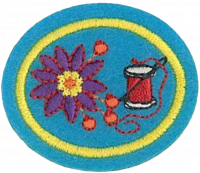AY Honors/Kanzashi/Answer Key
1
Kanzashi (簪) are hair ornaments used in traditional Japanese hairstyles.
Kanzashi were first used in Japan during the Jōmon period. During that time, a single thin rod or stick was considered to have mystical powers which could ward off evil spirits, so people would wear them in their hair. This is also when some of the first predecessors of the modern Japanese hair comb began to appear.
During the Nara period, a variety of Chinese cultural aspects and items were brought to Japan, including zan (written with the same Chinese character as kanzashi) and other hair ornaments. During the Heian period, the traditional style of putting hair up was changed to wearing it long, tied back low. It was at this time that kanzashi began to be used as a general term for any hair ornament, including combs and hairpins. During the Azuchi-Momoyama period, the hairstyles changed from the taregami (垂髪?), or long straight hair, to the wider variety of "Japanese hair" (日本髪 Nihongami?) which make more use of hair ornaments.
Kanzashi came into wide use during the Edo period, when hairstyles became larger and more complicated, using a larger number of ornaments. Artisans began to produce more finely crafted products, including some hair ornaments that could be used as defensive weapons. During the latter part of the Edo period, the craftsmanship of kanzashi reached a high point, with many styles and designs being created (see Types of kanzashi, below).
Nowadays, kanzashi are most often worn by brides; by professional kimono wearers such as geisha, tayū and yujo; or by adepts in Japanese tea ceremony and ikebana. However, there is currently a revival among young Japanese women who wish to add an elegant touch to their business suit. There are many varieties and many styles of wearing kanzashi. The way a geisha wears her kanzashi indicates her status immediately to an informed audience according to the type and location of the kanzashi. Maiko (apprentice geisha) usually wear more numerous and elaborate kanzashi than older geisha and progress through several hairstyles where the kanzashi must be worn in a fixed pattern.
Tsumami kanzashi has been officially designated as a traditional Japanese handcraft in the Tokyo region since 1982.[1] Traditionally trained professional artisans typically undergo five to ten years of apprenticeship. However, the petal-folding technique has become a popular hobby, due to instructional books, kits, and lessons from sources such as the Tsumami Kanzashi Museum in Shinjuku. Some students have bypassed the traditional apprenticeship system to establish themselves as independent professional artisans of tsumami kanzashi in Japan.
2
With hana kanzashi, the long fluttering flower is characteristic of maiko. These are created from squares of silk by a technique known as tsumami (pinching). Each square is folded multiple times with the aid of tweezers and cut into a single petal. Flowers are made from these folded fabric petals and may contain anywhere from five petals to 75 or more, depending on the particular flower made. A 'hana kanzashi' is a cluster of these flowers, and may or may not include bira-bira and/or long streamers of tsumami petals, fashioned to look like hanging wisteria petals. Generally, hana kanzashi are worn in pairs, one on either side of the head, often with a complementary kushi and/or with several individual flowers scattered about the hair.The flowers are blued to backings of metal or cardboard that are attached to a wire and are bunched together to make bouquets and other arrangements. Additional detailing of stamens is created by the use of mizuhiki, which is a strong, thin twine made from washi paper, and is often coloured and used for decorative works.
3
4
5
6
7
8


